learning from europe
In down times, Fall Creek Vineyards bet big on Texas wine and the gamble paidoff
- The vineyards are located eighty miles northwest of Austin in the Texas HillCountryPhoto by Matt McGinnis
- Fall Creek Vineyards WinePhoto by Matt McGinnis
 Fall Creek Vineyards was established in 1975 by Texas businessman/rancher, EdAuler and his wife, Susan.Photo by Matt McGinnis
Fall Creek Vineyards was established in 1975 by Texas businessman/rancher, EdAuler and his wife, Susan.Photo by Matt McGinnis
“This isn’t an easy business. It takes a tremendous amount of work and skill. It's also a big gamble.”
Ed Auler’s words bounced around in my head. I had just driven about two hours from Austin to visit with him at his winery, Fall Creek Vineyards. On the way I’d passed dry river beds, scorched fields and groves and groves of sun-seared trees dying by the dozens; all victims of the most severe single-year drought in Texas history and the hottest summer ever recorded in the United States. The weather this year makes me wonder why anyone would gamble with producing wine in Texas.
If it weren’t for Ed Auler, perhaps no one would bother trying to make wine here at all. He’s one of the Texas wine industry pioneers that paved the way.
In the early 1970s, the Auler family had been in cattle ranching for five generations. At the time the cattle business was going south. Ed thought about growing pecans and peaches as an alternative. Then the crazy notion of growing grapes to produce wine came up. He didn’t know much about wine, but his wife, Susan, knew a little more encouraged him to take a trip to Europe to further his knowledge. Once in Europe, the couple realized various European wine regions bore similarities to Texas and its growing conditions.
When they returned stateside, Ed and Susan planted an experimental vineyard. It worked well, so they doubled down and bought more land on the northwest shore of Lake Buchanan where the prevailing breeze cools the air quickly at night. Grapes love hot days and cool nights, and the sandstone and limestone rich soil in the area is transported from the High Plains of Texas by the Colorado River, reminiscent of the premier soils in wine regions in Europe. It was the right location to take a gamble on wine production.
It was 1975 when the couple first planted the vineyards and 1979 when they opened the Fall Creek Vineyards winery. It was only the second winery in Texas, closely following Llano Estacado Winery, which opened in 1978. Without a community of wine makers to turn to for advice, the early days were fraught with trial-and-error. So the Aulers experimented with grapes, seeking out the varietals that thrived, at one point growing 25 on the property.
In 1990, Mother Nature had a Royal Flush and blew a catastrophic freeze into the Fall Creek vineyards. The only thing that survived was the Chenin Blanc vines, but the Aulers weren’t about to give up. They took the opportunity to replant the vineyards with new trellising and other varietals. Not long after, they were dealt another blow when Pierce’s Disease sucked the life out of the vines, forcing Fall Creek to source grapes from other suppliers. Rather than betting everything on their own grapes a third time, they put a program together that spread the chips to other vineyards around the state to minimize risk.
Today, Fall Creek vineyards are planted with Black Spanish Lenoir, a neutral blending grape, and they buy grapes on long-term contract, such as Chenin Blanc from Mesa Vineyards in Pecos County and Tempranillo from Salt Lick Vineyard southwest of Austin.
Owing to the Aulers' European self-education, the two acquired a European taste for wine. The climate at Fall Creek is at once like Rioja in Spain and Southern France, yet is its own region with a singular style. Fall Creek Vineyards employs Burgundian wine-making techniques in pursuit of the European taste profile. To further hone their winery's technique, they called on renowned winemaker André Tchelistcheff as a wine consultant. Tchelistcheff is credited with creating a Napa-style for Cabernet while working at Beaulieu Vineyards (BV), and he brought some of that “new world” flair to Fall Creek; the Fall Creek wines respond well to technology such as cold fermentation and precision processes.
One of Tchelistcheff’s influences is his encouragement of the Bordeaux blend, Meritus. He tasted the wine and really liked it. Tchelistcheff encouraged the Aulers to set aside Cabernet Sauvignon, Merlot and Bordeaux varieties and give them white-glove treatment to make a special wine: don’t let the grapes get too hot; don’t let the skins stay on too long; age the wine in oak barrels and leave it alone. This is the formula Fall Creek has followed since the 1980s. Meritus is only made in the years that it works out well. Fall Creek won’t bottle it unless they feel it’s worth it. “This is Texas. Texas weather can be our best friend or our worst enemy. Some years we can make Meritus, some years we can’t,” says Ed.
Making high-end wine satisfies part of the market, but there is also significant demand for every-day drinkers. To quench that thirst, Fall Creek makes a fruit forward Merlot and Granite Reserve Cabernet, both easy-drinking red wines at affordable prices. They also introduced two value lines: Twin Springs Winery and Mission San Antonio de Valero. The Twin Springs Sweet Red, Sweet White, Sweet Blush and the off-dry Merlot-based, Ed’s Smooth Red, all sell very well.
The Aulers' gamble on Texas wine has paid off. In the beginning, Fall Creek produced 250 cases; now they are making 55,000 cases a year and splitting at the seams. They recently installed a new bottling line that can handle 2,000 cases a day and have even more expansion plans.
The wines are receiving national attention, and the Aulers will soon sell their line of sweet wines out of state. The acceptance of the Twin Springs and Mission San Antonio de Valero second lines will determine how big the winery grows. Despite the early challenges, Ed Auler reports that making wine in Texas is very satisfying.
“This is not a widget. It’s something you put yourself in and put your signature on. It’s a combination of working with mind and hands like being a plumber, electrician, chemist, physicist, accountant, PR and lawyer at the same time. The moments that bring satisfaction are when I know people enjoy my wine.”
That sounds like a winning bet.
---
The Aulers poured a line-up of wines for me to try and lovingly described each one:
2010 Vintage Chardonnay Texas
Fall Creek treats its Chardonnay to cold fermentation and retain the character of the fruit. It sees a little time in oak to round it out, without over powering the fruit and goes through partial malolactic fermentation for a richer texture. This crisp and refreshing wine would pair well with anything from deli sandwiches to grilled sea bass.
Look: Light golden with good clarity.
Smell: The Chardonnay has tropical scents of pineapple and honey.
Taste: This is a light style Chard with fresh honeydew, green apple and citrus flavors. It has a nice balance of fruit and acidity with a smooth mouthfeel. The clean finish is neither buttery, nor over-oaked.
Price: $12
2010 Fall Creek Vineyards Chenin Blanc, Texas
It turns out Ed doesn’t personally care for dry Chenin Blanc, but the University of Texas asked if he would produce experimental grapes. He agreed to grow Chenin Blanc. To achieve a hint of sweetness, fermentation is stopped leaving 2 percent residual sugar. It is then fine filtered and gets a kiss of oak. This is a “perfect wine for people that like to talk dry and drink sweet.” It pairs well with spicy food like Thai and Cajun cuisine.
Look: The sunny flaxen wine has good viscosity and clings to the glass.
Smell: The Fall Creek Chenin Blanc has a playful nose of cotton candy, honey suckle and toast.
Taste: Fruity pear and nectarine flambé greet the palate, followed by toasted marshmallow on the finish. It goes down smooth.
Price: $8
Ed’s Smooth Red
Here is a wine for people who don’t take wine too seriously. It’s fun and easy drinking. Its best served slightly chilled, but not as cold as you might pour white wine. It’s a fine accompaniment to Texas BBQ and Tex-Mex food.
Look: An inviting ruby red glimmering in the glass.
Smell: A burst of berry scents greet the sniffer with a touch of oakiness.
Taste: Ed is slightly sweet and tastes like a smoky blueberry tart.
Price: $10
2009 Fall Creek Vineyards Tempranillo, “Salt Lick Vineyards” Texas Hill Country
The grapes for the Fall Creek Tempranillo are grown by Scott Roberts at the Salt Lick Vineyard in Driftwood, Texas. The climate is similar to Rioja, Spain and the grapes are doing very well in Texas. The production is limited, so this wine is only available in the tasting room and in a few select restaurants in Austin.
Look: Bright garnet with a deep red center like a king’s velvet robe.
Smell: It has a rich fragrance of smoked plum and raspberry.
Taste: The Fall Creek Tempranillo is lush with cherry, blackberry and nutmeg with a long finish. Delicious. I was impressed with this wine and wanted more. Fortunately Ed sent me home with the rest of the bottle to share with Beautiful Wife.
Price: $30 available in tasting room in very limited quantities
2006 Meritus
The crown jewel of the Fall Creek line-up is made from 74 percent Cabernet Sauvignon, 25 percent Merlot and 1 percent Syrah. The award winning wine can stare down the thickest Texas steak with grace and finesse.
Look: The Meritus is brick red with burnt sienna in the glass.
Smell: The nose is full of sweet black cherry, vanilla, rhubarb and oak.
Taste: This is a big wine with cassis, blackberry, tobacco and chocolate. It has a good balance of tannins and a long oaky finish. It has the underpinnings of traditional Bordeaux with a little new world punch.
Price: $40


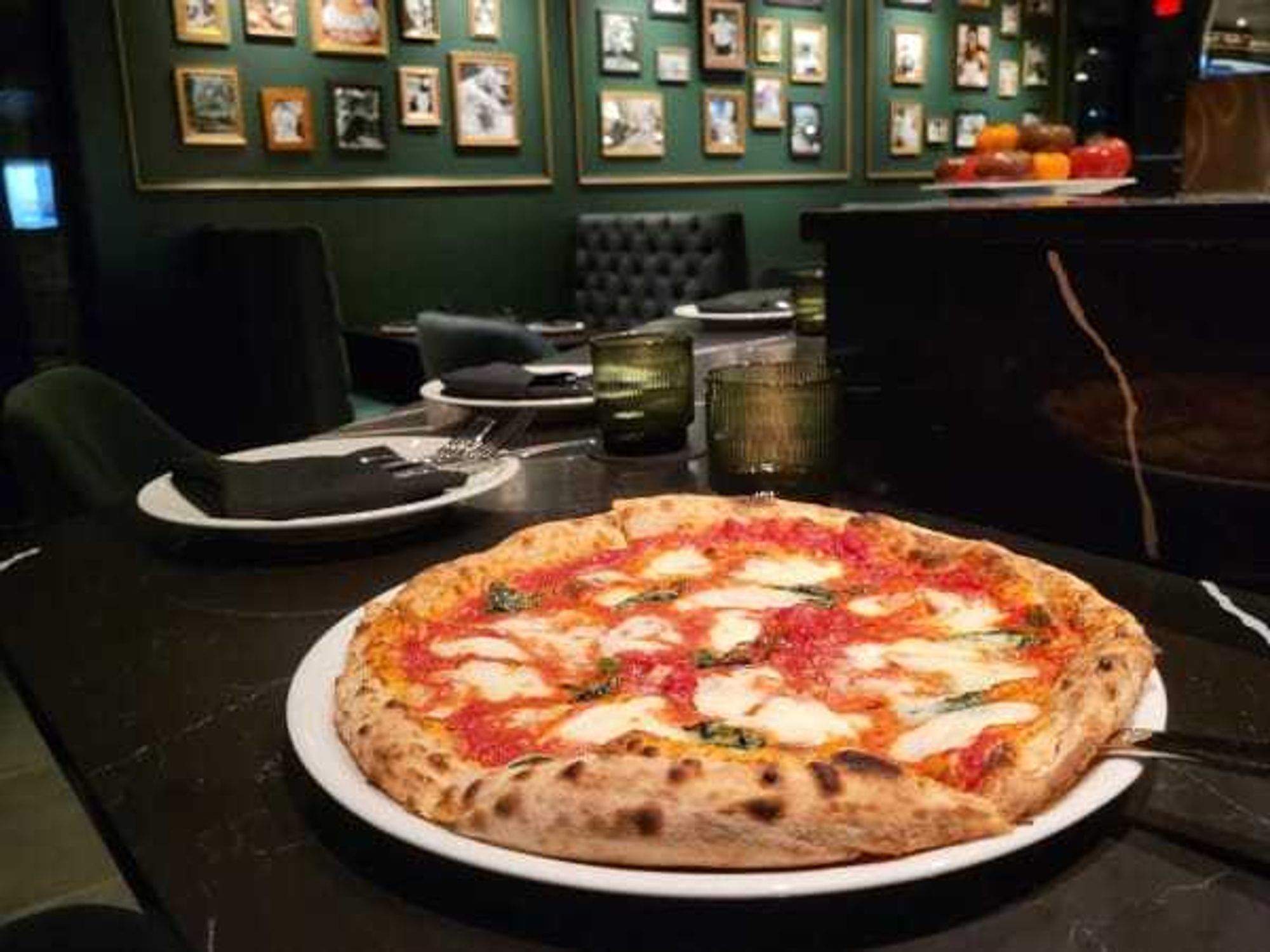
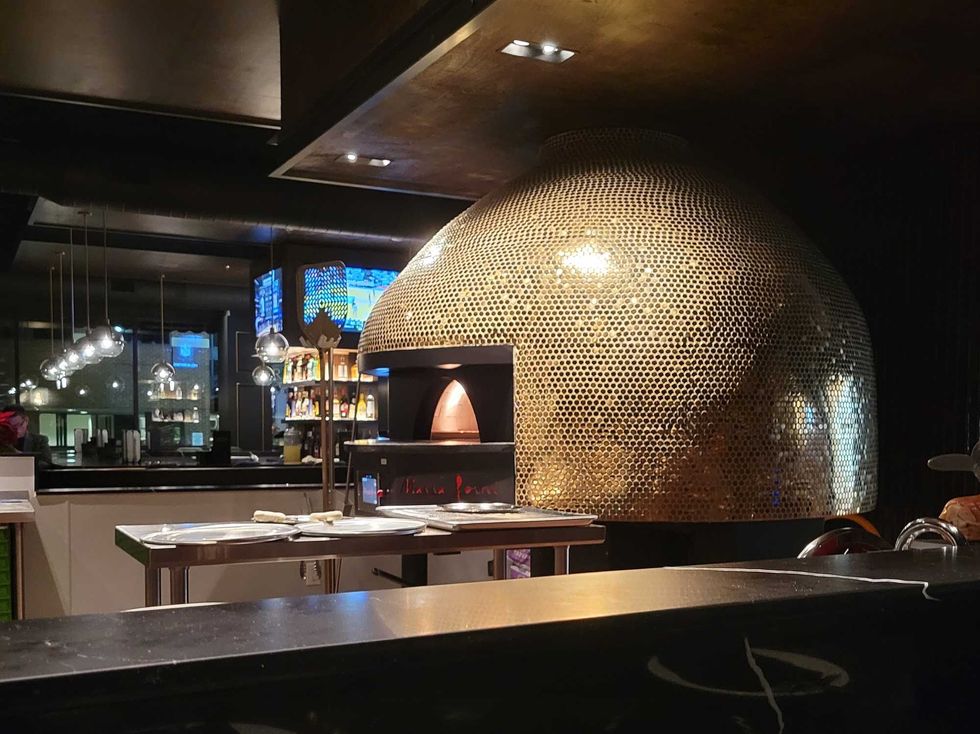 This mirrored pizza oven is rightfully the center of attention.Photo by Brianna Caleri
This mirrored pizza oven is rightfully the center of attention.Photo by Brianna Caleri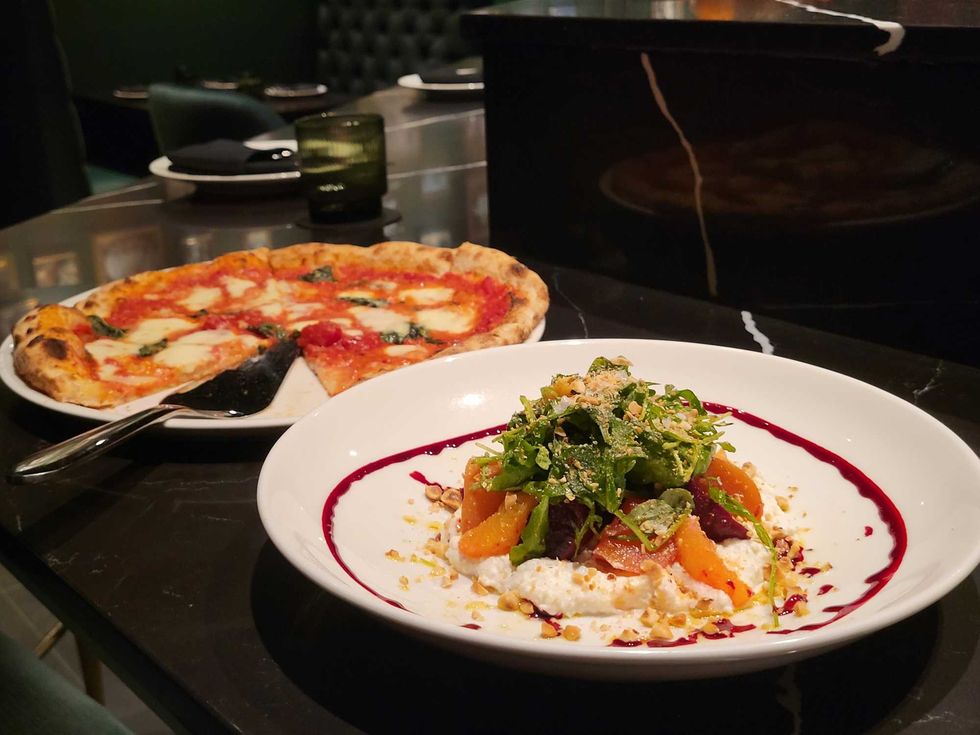 This beet and citrus salad combines layers of flavor and texture.Photo by Brianna Caleri
This beet and citrus salad combines layers of flavor and texture.Photo by Brianna Caleri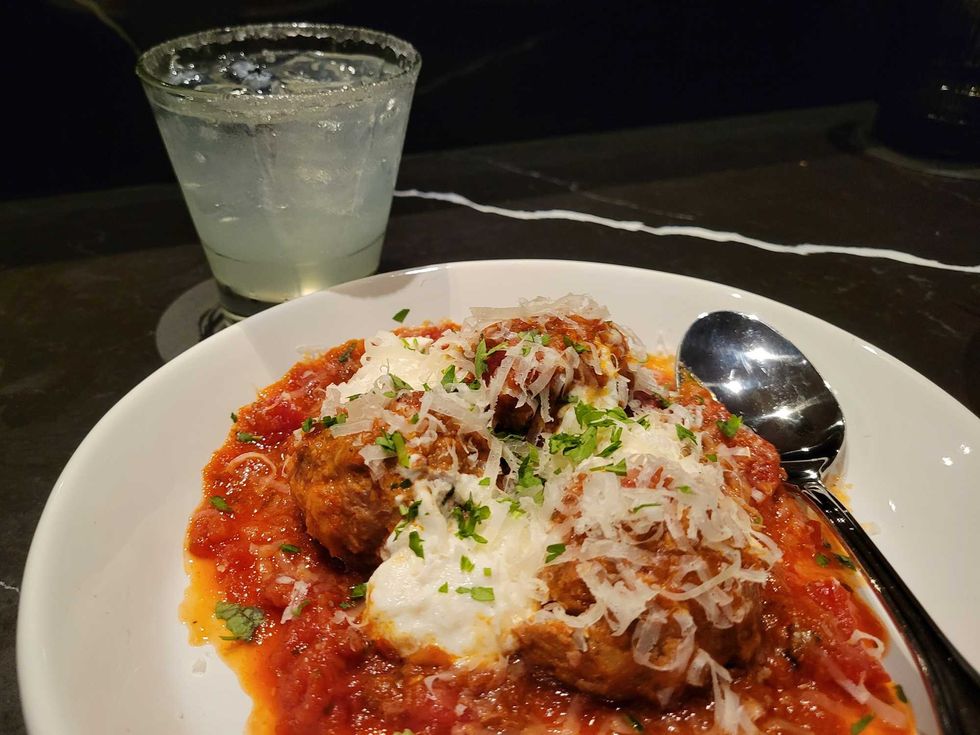 A Blue Amalfi cocktail and meatballs.Photo by Brianna Caleri
A Blue Amalfi cocktail and meatballs.Photo by Brianna Caleri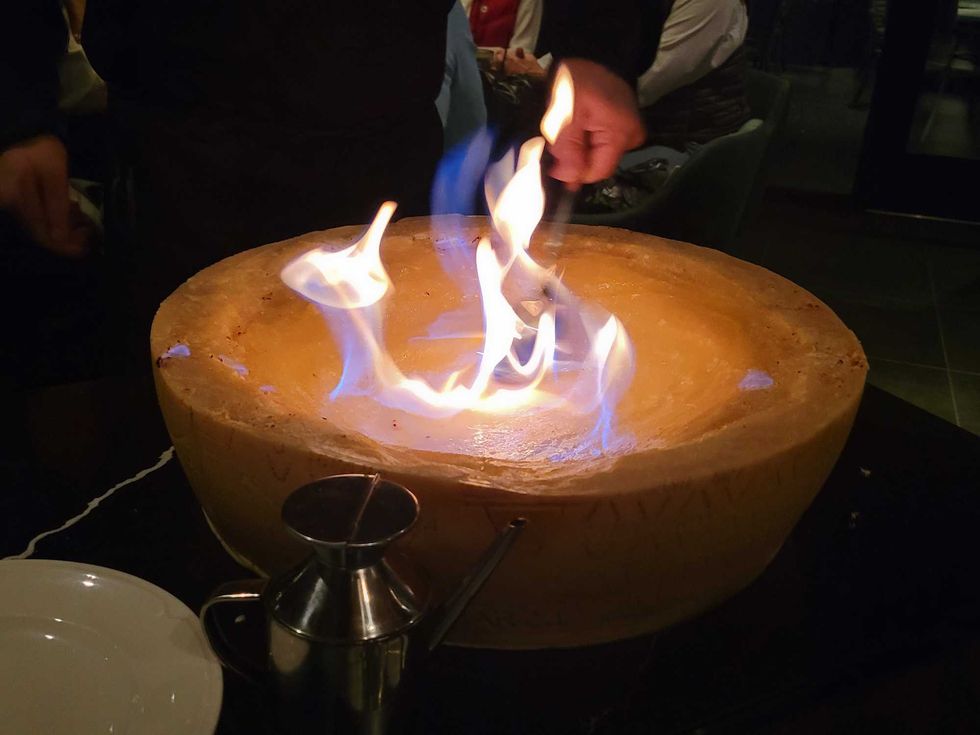 A server melts the interior of a cheese wheel to prepare tagliatelle.Photo by Brianna Caleri
A server melts the interior of a cheese wheel to prepare tagliatelle.Photo by Brianna Caleri Moderna's chic interior.Photo by Brianna Caleri
Moderna's chic interior.Photo by Brianna Caleri